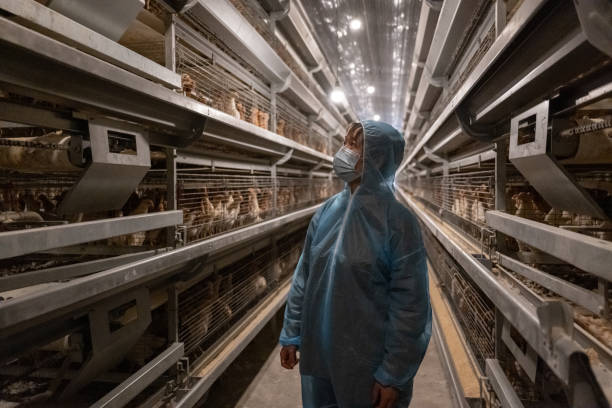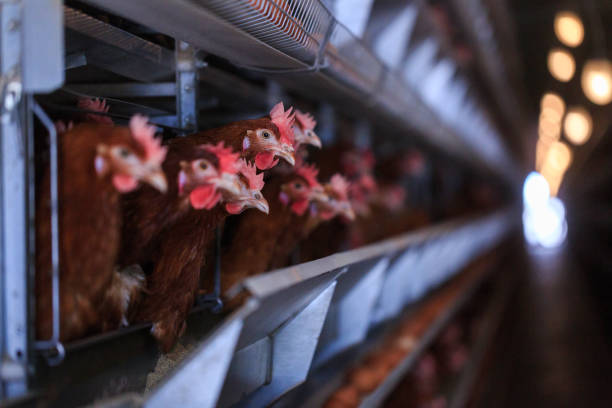
Optimizing Your Uganda Chicken Farm: A Smart Data Management Plan
Optimizing Your Uganda Chicken Farm: A Smart Data Management Plan
Uganda’s poultry industry is on the rise, with more and more people recognizing the potential for a profitable business in raising chickens. But as any seasoned farmer will tell you, success isn’t just about having healthy birds and providing them with the right feed. It’s also about managing your farm efficiently, and in today’s world, that means implementing a smart data management plan.

Think of your chicken farm as a complex ecosystem. There’s a lot going on – feed consumption, egg production (if you’re raising layers), mortality rates, temperature fluctuations, and so much more. Trying to keep track of all this information in your head, or even on scattered pieces of paper, is a recipe for inefficiency and potential losses. A well-designed data management plan allows you to collect, analyze, and act on information to optimize your operations, maximize profits, and minimize risks.

**Why Data Management is Crucial for Ugandan Chicken Farms**
Before diving into the nitty-gritty of creating a data management plan, let’s understand why it’s so important, especially in the Ugandan context:
* **Improved Decision Making:** Data provides insights that intuition alone cannot. By analyzing trends in egg production, feed conversion ratios, or mortality rates, you can make data-driven decisions about everything from feed formulations to disease prevention strategies.
* **Early Problem Detection:** A good data management system will flag anomalies and potential problems early on. For example, if you see a sudden drop in egg production, you can investigate the cause (e.g., disease outbreak, poor feed quality, stress) and take corrective action before it impacts your entire flock.
* **Increased Efficiency:** By monitoring feed consumption, water usage, and other key metrics, you can identify areas where you can improve efficiency and reduce waste. This can translate to significant cost savings over time.
* **Better Flock Management:** Data helps you track the performance of your flock, identify individual birds that are underperforming, and make informed decisions about culling or replacement.
* **Enhanced Biosecurity:** By recording vaccination schedules, medication administration, and sanitation practices, you can improve your farm’s biosecurity and reduce the risk of disease outbreaks.
* **Access to Financing:** Many lenders are more willing to provide financing to farms that can demonstrate sound management practices and a clear understanding of their operations. A robust data management system can provide the documentation they need.
* **Compliance with Regulations:** As the Ugandan poultry industry becomes more regulated, data management will become increasingly important for demonstrating compliance with food safety and animal welfare standards.
**Building Your Smart Data Management Plan: A Step-by-Step Guide**
Creating a data management plan for your chicken farm doesn’t have to be complicated. Here’s a step-by-step guide to get you started:
**1. Identify Key Performance Indicators (KPIs):**
The first step is to determine what data you need to collect. This will depend on your specific goals and objectives. However, some common KPIs for chicken farms include:
* **Egg Production (for Layers):** Number of eggs produced per hen per day, week, or month.
* **Feed Consumption:** Amount of feed consumed per hen per day, week, or month.
* **Feed Conversion Ratio (FCR):** Amount of feed required to produce one kilogram of eggs or one kilogram of broiler meat.
* **Mortality Rate:** Percentage of birds that die within a given period.
* **Body Weight (for Broilers):** Average weight of birds at different ages.
* **Water Consumption:** Amount of water consumed per hen per day, week, or month.
* **Temperature and Humidity:** Daily temperature and humidity levels inside the chicken house.
* **Vaccination and Medication Records:** Dates and types of vaccinations and medications administered.
* **Sales and Revenue:** Income generated from the sale of eggs or broiler meat.
* **Expenses:** Costs associated with feed, labor, medication, utilities, and other inputs.
**2. Choose Your Data Collection Methods:**
Once you’ve identified your KPIs, you need to decide how you’re going to collect the data. There are several options available, ranging from manual methods to automated systems:
* **Manual Record Keeping:** This involves recording data in notebooks, spreadsheets, or on paper forms. It’s the simplest and most affordable option, but it can be time-consuming and prone to errors.
* **Spreadsheet Software (e.g., Microsoft Excel, Google Sheets):** This allows you to organize and analyze data electronically. It’s more efficient than manual record keeping, but it still requires manual data entry.
* **Farm Management Software:** There are several software packages specifically designed for poultry farm management. These systems can automate data collection, analysis, and reporting. They often include features such as egg counters, feed weighing systems, and environmental sensors.
* **Mobile Apps:** Several mobile apps are available that allow you to collect data on your smartphone or tablet. These apps can sync with farm management software or spreadsheet programs.
Consider your budget, technical expertise, and the size of your operation when choosing your data collection methods. For small farms, manual record keeping or spreadsheet software may be sufficient. However, for larger farms, farm management software is often a worthwhile investment.
**3. Implement a Data Collection Routine:**
Consistency is key to effective data management. Establish a routine for collecting data and stick to it. This might involve weighing feed daily, recording egg production weekly, and monitoring temperature and humidity hourly.
Train your staff on how to collect data accurately and consistently. Provide them with clear instructions and the necessary tools. Double-check data entries for errors and inconsistencies.
**4. Store and Organize Your Data:**
Choose a secure and organized method for storing your data. This could be a physical filing system, a computer hard drive, or a cloud-based storage service.
Create a standardized naming convention for your files and folders. This will make it easier to find and retrieve data when you need it. Back up your data regularly to prevent loss due to equipment failure or other unforeseen events.
**5. Analyze Your Data:**
Collecting data is only half the battle. You also need to analyze it to gain meaningful insights. This involves looking for trends, patterns, and anomalies in your data.
Use spreadsheet software or farm management software to generate reports and charts. These visual aids can help you identify areas where you can improve your operations. Compare your data to industry benchmarks to see how your farm is performing relative to others.
**6. Take Action Based on Your Findings:**
The ultimate goal of data management is to improve your farm’s performance. Use the insights you gain from your data analysis to make informed decisions about your operations.
Adjust feed formulations, implement disease prevention strategies, improve biosecurity practices, or optimize your flock management practices. Track the results of your actions to see if they are having the desired effect. Be prepared to adapt your strategies as needed.
**Specific Data Management Techniques for Ugandan Chicken Farms**
Here are some specific data management techniques that can be particularly beneficial for Ugandan chicken farms:
* **Feed Management:**
* Track feed consumption by type of feed (starter, grower, finisher).
* Monitor feed conversion ratios (FCR) for each stage of growth.
* Adjust feed formulations based on bird age, breed, and environmental conditions.
* Regularly check feed quality to ensure it meets nutritional requirements.
* **Egg Production (for Layers):**
* Record egg production daily or weekly, by hen house or pen.
* Monitor egg size, shell quality, and interior quality.
* Identify hens that are consistently laying poor-quality eggs.
* Adjust lighting schedules to optimize egg production.
* **Disease Management:**
* Maintain detailed records of vaccinations, medications, and disease outbreaks.
* Monitor mortality rates closely and investigate any sudden increases.
* Implement strict biosecurity measures to prevent the spread of disease.
* Consult with a veterinarian regularly to develop a disease prevention plan.
* **Environmental Control:**
* Monitor temperature, humidity, and ventilation levels in the chicken house.
* Adjust ventilation rates to maintain optimal air quality.
* Provide adequate shade and cooling during hot weather.
* Ensure proper drainage to prevent waterlogging.
* **Financial Management:**
* Track all income and expenses.
* Calculate your profit margin for each batch of chickens.
* Identify areas where you can reduce costs or increase revenue.
* Develop a budget and track your performance against it.
**Overcoming Challenges to Data Management in Uganda**

While the benefits of data management are clear, there are also some challenges to implementing it effectively in Ugandan chicken farms:
* **Limited Access to Technology:** Many Ugandan farmers lack access to computers, smartphones, and reliable internet connections.
* **Low Levels of Literacy and Numeracy:** Some farmers may have difficulty collecting and interpreting data.
* **Lack of Training and Support:** Farmers may need training on how to use data management tools and techniques.
* **Cost of Technology:** Farm management software and other technology can be expensive.
* **Resistance to Change:** Some farmers may be resistant to adopting new methods.
To overcome these challenges, it’s important to:
* **Choose appropriate technology:** Select data management tools that are affordable, easy to use, and compatible with the available infrastructure.
* **Provide training and support:** Offer training programs to help farmers develop the skills they need to collect and analyze data.
* **Demonstrate the benefits of data management:** Show farmers how data can help them improve their farm’s performance and profitability.
* **Start small:** Begin with a simple data management plan and gradually expand it as needed.
* **Seek support from extension officers and other agricultural professionals:** They can provide valuable advice and assistance.
**The Future of Data Management in Uganda’s Poultry Industry**
As the Ugandan poultry industry continues to grow, data management will become increasingly important for success. Farmers who embrace data-driven decision-making will be better positioned to compete in the marketplace and achieve sustainable profitability.
The development of affordable and user-friendly data management tools, coupled with increased access to training and support, will make it easier for Ugandan farmers to adopt these practices. The government and other stakeholders can play a crucial role in promoting data management by providing funding for research and development, offering training programs, and creating incentives for farmers to adopt new technologies.
In conclusion, optimizing your Uganda chicken farm requires a smart data management plan. By collecting, analyzing, and acting on relevant data, you can improve your farm’s efficiency, profitability, and sustainability. While there are challenges to implementing data management in the Ugandan context, these can be overcome with the right approach. Embrace the power of data and unlock the full potential of your chicken farm.
